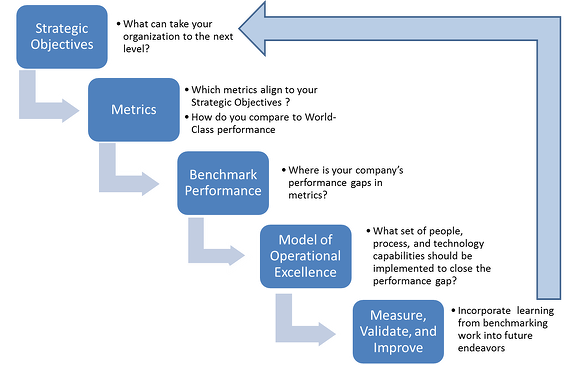Many companies attempt to use benchmarking research to uncover hidden opportunities, implement best practices, and create a competitive advantage. Unfortunately, many companies fall short of their goals in these areas.
How to Use Benchmarking Research for Sustained Business Benefits
There is a close relationship between a company's strategic objectives and how they benchmark performance. However, for many companies, it is often unclear how these these two processes relate. At LNS Research we have developed a formal methodology for managing the Benchmarking processes to ensure consistent results will be achieved overtime.
In this post we are going to highlight the overall Methodology. In future posts we will dive down into the details of the individual sections.
Benchmarking Methodology

- Create Strategic Objectives - Often established at the corporate, divisional, or departmental level. Strategic Objectives should be established under the guidance of it's own established methodology. Multiple stake-holders and data sources should be included in the process, including: customers, vendors, partners, competitors, regulatory bodies, already established strategic objectives, previous benchmarking activities, and more.
- Identify the Set of Metrics that Align to Strategic Objectives - It is important that the organization has a clear understanding of the metrics that can impact success in specific Strategic Objectives. These metrics should include a set of primary metrics that directly measure the success of an established Strategic Objective. These metrics should include both financial as well as operational metrics and can also include a set of secondary metrics that correlate to improvement in primary metrics.
- Establish World Class Performance in Metrics - Often metrics that align to Strategic Objectives can be measured internally but aren't reported externally. This makes it difficult to know with certainty how well an organization is performing against Strategy Objectives. In such situations, it is important to set goals for the Metrics you are measuring. To do this it is important to establish what World-Class performance in these metrics is. At LNS Research World-Class performance is defined as the top 1% of performers in a specific metric.
- Establish Gaps in Current Performance - Identify where your biggest opportunities for improvement are in the metrics that can impact your Strategic Objectives.
- Establish People, Process, and Technology Capabilities Correlated with Improving Metrics - With a good understanding of the metrics that matter to your organization, it is time to build a plan for improving performance. The first step is to understand which business capabilities correlate to improvement of the identified metrics.
- Build a Model of Operational Excellence - Incorporate the capabilities giving the most bang for the buck into a Model for achieving Operational Excellence. This model should create an integrated management system for achieving the stated Strategic Objectives through implementing the right business capabilities and improving the right metrics.
- Measure, Verify, and Improve - Benchmarking initiatives should not have a set start and end date. Rather they should be part of an ongoing Continuous Improvement process. It is important to ensure over time that the progress being made is in line with the stated Strategic Objectives and to take the learnings from going through the benchmarking process into refining future Strategic Objectives
To make this methodology more concrete, in future posts we will go through an example and conduct a deep dive into each of the 7 steps.
Access this NEW eBook, "Manufacturing Metrics in an IoT World: Measuring the Progress of the Industrial Internet of Things," presents results from the fourth iteration of the biennial Metrics that Matter research study conducted between LNS Research and MESA International. It places particular focus on what IIoT means to manufacturers in the MOM space.